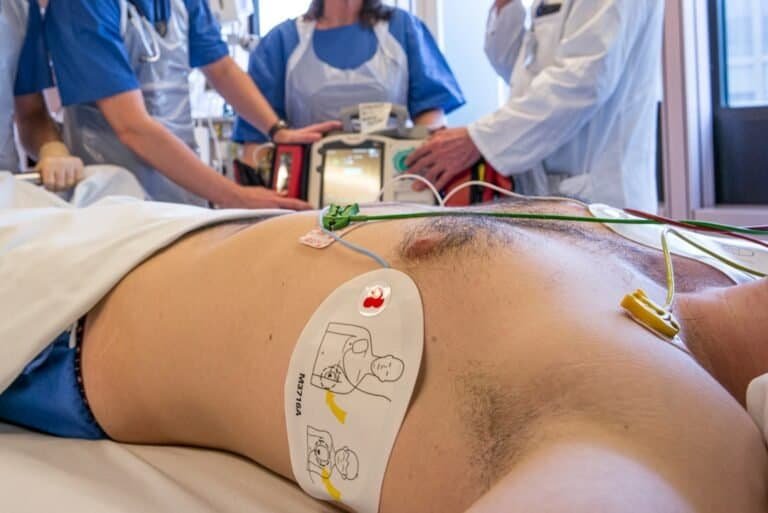In recent years, telemedicine has emerged as a revolutionary force in the healthcare landscape, transforming how patients access medical services. The COVID-19 pandemic acted as a catalyst, propelling telehealth into the mainstream as individuals sought safe alternatives to in-person visits. You may have noticed that many healthcare providers quickly adapted to this new reality, offering virtual consultations and remote monitoring options.
This shift not only ensured continuity of care during a time of crisis but also highlighted the potential of telemedicine to bridge gaps in healthcare access. As a result, you are now witnessing a significant increase in the adoption of telehealth services across various demographics, making it easier than ever for you to connect with healthcare professionals from the comfort of your home. The rise of telemedicine is also fueled by advancements in technology and the growing acceptance of digital health solutions.
With smartphones, tablets, and high-speed internet becoming ubiquitous, you can easily schedule appointments, receive diagnoses, and even manage prescriptions online. This convenience has led to a surge in telehealth platforms, each offering unique features tailored to meet your specific needs. As you explore these options, you may find that the USA Doctor Network stands out as one of the best and most affordable teams dedicated to helping you achieve your health goals.
Their commitment to providing accessible and quality care through telemedicine ensures that you can receive the support you need without breaking the bank.
Key Takeaways
- Telemedicine has seen a significant rise in popularity, especially in the wake of the COVID-19 pandemic, as more patients and healthcare providers turn to virtual consultations and remote monitoring.
- The benefits of telemedicine for patients include increased convenience, reduced travel time and costs, improved access to specialists, and the ability to receive care from the comfort of their own homes.
- Telemedicine is changing the doctor-patient relationship by fostering more frequent and convenient communication, allowing for better monitoring of chronic conditions, and enabling patients to take a more active role in their own healthcare.
- Technology plays a crucial role in telemedicine, enabling secure video conferencing, remote monitoring devices, electronic health records, and artificial intelligence to enhance the delivery of care.
- Telemedicine has the potential to revolutionize mental health care by increasing access to therapy and counseling services, reducing stigma, and providing more personalized and convenient treatment options.
- The future of telemedicine is likely to involve further integration with wearable devices, remote monitoring technologies, and AI-driven diagnostics, as well as expanded use in rural and underserved areas.
- Despite its many benefits, telemedicine also faces challenges and limitations, including concerns about data security, regulatory barriers, reimbursement issues, and the potential for exacerbating health disparities.
- Telemedicine has the potential to improve healthcare accessibility by reaching patients in remote or underserved areas, reducing barriers to care, and providing more flexible and convenient options for receiving medical treatment.
The Benefits of Telemedicine for Patients
Enhancing Convenience in Healthcare
Telemedicine has revolutionized the way patients receive medical care, offering unparalleled convenience and flexibility. Gone are the days of waiting in crowded waiting rooms or taking time off work to attend appointments. With telehealth, patients can now consult with their doctors from anywhere, whether it’s the comfort of their own home, office, or even while traveling.
Flexibility and Accessibility
This flexibility allows patients to fit healthcare into their busy schedules without compromising on quality. Telemedicine also reduces travel time and costs associated with in-person visits, making healthcare more accessible than ever before. This increased accessibility is particularly beneficial for those with mobility issues, remote locations, or busy lifestyles.
Improved Health Outcomes and Reduced Stigma
Telemedicine can lead to improved health outcomes for patients by facilitating regular check-ins and follow-ups through virtual appointments. This ongoing communication fosters a stronger relationship between patients and their doctors, allowing for timely interventions when necessary. Additionally, telemedicine can help reduce the stigma associated with seeking care for certain conditions, such as mental health issues or chronic illnesses.
Personalized Care with the USA Doctor Network
With the USA Doctor Network, patients can access a team that prioritizes their well-being and offers affordable solutions tailored to their unique health needs. This personalized approach ensures that patients receive the care they need, when they need it, without breaking the bank.
How Telemedicine is Changing the Doctor-Patient Relationship

Telemedicine is fundamentally reshaping the dynamics of the doctor-patient relationship. Traditionally, this relationship was characterized by face-to-face interactions in clinical settings, which could sometimes create barriers to open communication. However, with telehealth, you may find that the virtual environment encourages more candid discussions about your health concerns.
The comfort of being in your own space can lead to increased transparency and honesty during consultations, allowing your healthcare provider to better understand your needs and preferences. Furthermore, telemedicine promotes a more collaborative approach to healthcare. You are no longer just a passive recipient of medical advice; instead, you can actively participate in your treatment plan.
With easy access to your medical records and test results through online portals, you can engage in informed discussions with your doctor about your health goals. The USA Doctor Network exemplifies this collaborative spirit by empowering you with resources and support tailored to your individual journey toward better health. Their team is dedicated to ensuring that you feel heard and valued throughout the process.
The Role of Technology in Telemedicine
| Metrics | Data |
|---|---|
| Number of telemedicine users | Increasing by 38% annually |
| Telemedicine market size | Projected to reach 130.5 billion by 2025 |
| Effectiveness of remote monitoring | Reduces hospital readmissions by 50% |
| Telemedicine adoption rate | Surged by 340% in rural areas |
| Cost savings from telemedicine | Estimated at 19.7 billion annually |
Technology plays a pivotal role in the success of telemedicine, enabling seamless communication between patients and healthcare providers. Video conferencing tools, secure messaging platforms, and mobile health applications have all contributed to making virtual consultations not only possible but also effective. As a patient, you benefit from these innovations by having access to real-time consultations and immediate responses to your health inquiries.
This technological integration allows for a more dynamic exchange of information, ensuring that you receive timely care when you need it most. Moreover, technology enhances the overall patient experience by providing tools for self-management and education. Many telehealth platforms offer resources such as symptom checkers, medication reminders, and wellness tracking features that empower you to take charge of your health.
With the USA Doctor Network’s commitment to leveraging technology for patient care, you can expect a user-friendly experience that prioritizes your needs. Their innovative approach ensures that you have access to comprehensive support that goes beyond traditional medical consultations.
Telemedicine and Mental Health Care
Telemedicine has proven particularly beneficial in the realm of mental health care, where access to services has historically been limited by stigma and geographical barriers. For many individuals like yourself, seeking help for mental health issues can be daunting; however, telehealth provides a more discreet and comfortable avenue for receiving support. Virtual therapy sessions allow you to connect with licensed mental health professionals from the privacy of your home, reducing anxiety associated with in-person visits.
This accessibility can lead to increased engagement in treatment and ultimately better mental health outcomes. Additionally, telemedicine facilitates continuity of care for those managing chronic mental health conditions. Regular check-ins through virtual appointments enable healthcare providers to monitor your progress closely and make necessary adjustments to your treatment plan.
The USA Doctor Network recognizes the importance of mental health care and offers affordable teletherapy options designed to meet your unique needs. By prioritizing mental well-being alongside physical health, they ensure that you have access to comprehensive care that addresses all aspects of your life.
The Future of Telemedicine

The Future of Telemedicine: A Promising Outlook
The future of telemedicine appears promising and full of potential. The ongoing integration of artificial intelligence (AI) and machine learning into healthcare systems is set to revolutionize how services are delivered. You may soon find yourself benefiting from AI-driven diagnostic tools that provide real-time insights into your health status or predictive analytics that help identify potential health risks before they become serious issues.
Enhanced Quality of Care and Personalized Health Information
These advancements will not only enhance the quality of care but also empower you with personalized health information tailored specifically to your needs. This means that you will have access to relevant and actionable health data that can help you make informed decisions about your well-being.
Regulatory Support and Expansion of Telehealth Services
Moreover, as telemedicine continues to gain traction, we can expect further regulatory support and reimbursement policies that promote its use across various healthcare settings. This shift will likely lead to an expansion of services offered through telehealth platforms, making it easier for you to access specialized care without geographical limitations.
USA Doctor Network: A Leader in Telehealth Evolution
The USA Doctor Network is at the forefront of this evolution, committed to providing affordable and comprehensive telehealth solutions that align with the future of healthcare delivery.
Challenges and Limitations of Telemedicine
Despite its many advantages, telemedicine is not without challenges and limitations that may affect your experience as a patient. One significant concern is the digital divide; not everyone has equal access to reliable internet or technology necessary for virtual consultations. This disparity can create barriers for certain populations, particularly those in rural areas or low-income communities who may struggle to access telehealth services.
As a result, some individuals may find themselves excluded from the benefits that telemedicine offers. Additionally, while telemedicine can facilitate many aspects of healthcare delivery, it may not be suitable for all medical conditions or situations. Certain diagnoses require hands-on examinations or diagnostic tests that cannot be performed remotely.
In such cases, you may still need to visit a healthcare facility for comprehensive evaluation and treatment. The USA Doctor Network understands these limitations and strives to provide a balanced approach by offering both telehealth services and traditional in-person care options when necessary.
Telemedicine and Healthcare Accessibility
Telemedicine has emerged as a powerful tool for improving healthcare accessibility for patients across various demographics. By breaking down geographical barriers and providing services remotely, telehealth enables individuals who may have previously faced challenges in accessing care—such as those living in rural areas or those with mobility issues—to receive timely medical attention. You may find that this increased accessibility leads to better health outcomes overall, as patients are more likely to seek care when it is convenient and readily available.
Furthermore, telemedicine has the potential to reduce disparities in healthcare access among marginalized populations. By offering affordable options through platforms like the USA Doctor Network, individuals from diverse backgrounds can connect with qualified healthcare professionals without financial strain. This commitment to accessibility ensures that everyone has an opportunity to prioritize their health and well-being regardless of their circumstances.
As telemedicine continues to evolve, it holds great promise for creating a more equitable healthcare system where all patients can thrive.
If you’re interested in learning more about how telemedicine can enhance your access to healthcare, consider reading the article “Telemedicine for Your Health Needs: Accessible Healthcare Wherever You Are.” This piece explores the benefits and convenience of using telemedicine services, which allow you to receive medical advice and care without the need to visit a doctor’s office physically. It’s a great resource for anyone looking to understand how modern technology is transforming healthcare delivery. You can read the full article by clicking on this link: Telemedicine for Your Health Needs: Accessible Healthcare Wherever You Are.
FAQs
What are telemedicine services?
Telemedicine services refer to the use of technology, such as video conferencing and remote monitoring, to provide healthcare services remotely. This allows patients to consult with healthcare providers without having to visit a physical clinic or hospital.
What types of healthcare services can be provided through telemedicine?
Telemedicine services can be used for a wide range of healthcare needs, including primary care consultations, mental health counseling, follow-up appointments, chronic disease management, and prescription refills. Some telemedicine platforms also offer specialist consultations and second opinions.
What are the benefits of using telemedicine services?
Some of the benefits of telemedicine services include increased access to healthcare, especially for individuals in rural or underserved areas, reduced travel time and costs for patients, improved convenience, and the ability to receive timely care without having to wait for an in-person appointment.
Are telemedicine services secure and private?
Telemedicine platforms are designed to adhere to strict privacy and security regulations, such as HIPAA in the United States. This means that patient information is protected and secure during telemedicine consultations. It is important for patients to use a reputable and secure telemedicine platform for their healthcare needs.
What technology is needed to access telemedicine services?
To access telemedicine services, patients typically need a device with a camera and microphone, such as a smartphone, tablet, or computer. They also need a reliable internet connection. Some telemedicine platforms may have specific software or apps that need to be downloaded for the consultation.
Are telemedicine services covered by insurance?
Many insurance companies and government healthcare programs, such as Medicare and Medicaid, now cover telemedicine services. However, coverage may vary depending on the specific insurance plan and the type of telemedicine service being provided. It is important for patients to check with their insurance provider to understand their coverage options for telemedicine.



